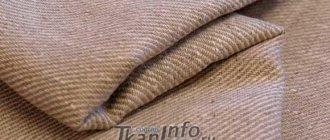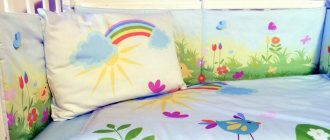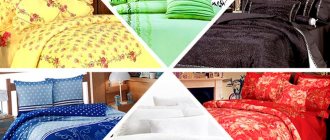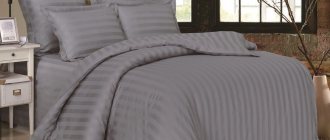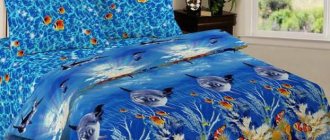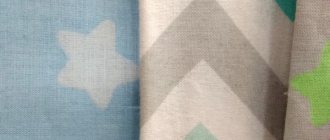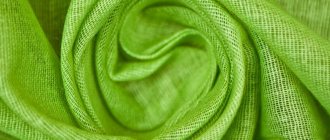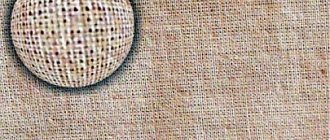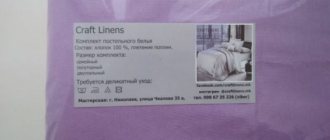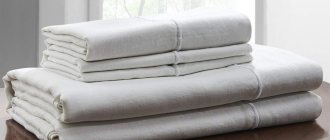Different materials have different densities, both surface and linear. Air permeability depends on this indicator, hygroscopicity to a lesser extent, and resistance to deformation and wear significantly depends. In turn, the density depends on the thickness of the threads, their number and the method of weaving.
What is density for bed linen?
Before answering the question: “What should be the density of bed linen?”, you need to understand what this parameter means. So, the density of linen is linear and surface.
Linear density is a parameter that determines the number of fabric threads per square centimeter of a product. Naturally, the parameter one square centimeter is accepted in Russia, but in the world lexicon it is one square inch.
Surface density is a parameter that determines grams of fiber per square meter of product.
Linear density of bed linen
According to its gradation, linear density is:
- Low – up to 30 threads per 1 sq. cm,
- Below average - from 30 to 40 threads per 1 sq. cm,
- Medium – from 40 to 55 threads per 1 sq. cm,
- Above average - from 55 to 80 threads per 1 sq. cm,
- High - from 80 to 120 threads per 1 sq. cm,
- Very high - from 120 to 280 threads per 1 sq.cm.
Fabric with a low density is considered to be cambric, with a density below average - calico, linen is a fabric with a medium density, fabrics with a density above the average include poplin and ranfors, high density is observed in satin and percale, and very high - in satin and jacquard.
Surface density of bed linen
Surface density is a much less transparent characteristic. This is because for each fabric such a characteristic as grammage per square meter is very subjective. It is impossible to say exactly how high-quality fabric with a high surface density is. For example, if we take domestic calico and poplin from China, then the latter material has a higher linear density and a lower surface density. At the same time, there is no doubt about the quality of the material. It's all about the method of weaving, the twisting of the threads and the tightness of their fit to each other.
Now let's look at the density of each specific type of material in order to determine which bedding density is the best.
What does the density indicator mean?
Weight markings can provide some insight into the quality of a textile, even if it cannot be seen with your own eyes. The higher the indicator, the more threads were used to create 1 cm2 of material, but it is also important to take into account the composition of the threads. Thin threads have a minimum specific gravity, which means they can be arranged much more densely. Consequently, they can be used to form a very dense canvas without gaps. Such fabric will be highly resistant to tearing and severe creasing. Using thick threads, they create textiles of low density, but with excellent softness and pliability. Such fabric will allow air to pass through well, but at the same time wrinkle quite a lot. It is important to take this into account when choosing, otherwise the finished products will not live up to expectations.
Calico bed linen
What is calico? Calico is 100% cotton, high-quality and durable material. It is calico that is often used to make bed linen; the threads of this material are interwoven in a cross pattern, resulting in a strong and thick fabric.
The formula for the quality of material, including calico, is quite simple: the thinner the thread, the higher the density of the fabric, and, consequently, the higher its quality. Calico can be sparse, with a low density of 80 grams per square meter, medium density with parameters from 90 to 100 grams per square meter, higher than average density in high-quality sets from 110 to 125 grams per square meter, high density with parameters from 130 to 160 grams per square meter. The optimal density for calico is 100-125 g/m2. In this case, more is not better, since the high density of calico implies a very coarse fabric that is difficult to use for bedding and home use.
Why should you choose bedding made from calico? It is inexpensive, practical, functional. If you are choosing a set for everyday use and are not obsessed with the softness of the products, then calico is an excellent choice for you.
What fabric density is best for curtains and upholstery?
Low density does not always mean low quality. For example, the finest lightweight silk fabrics less than 100 g/m2 are valued higher than dense ones. Thin organza with a density of about 45–60 g/m2 is used for sewing multi-layer and single-layer curtains. An interesting curtain fabric is tulle - an inexpensive low-density material (less than 20 g/m2), usually used for the kitchen. Affordable in cost, the weightless veil looks great in both simple and complex products – in particular, Roman blinds. Linen, wool and cotton materials have medium density. Curtain fabrics are denser, on average 120–180 g/m2, heavier and more expensive. Blackout is a very heavyweight, high-density curtain fabric that can darken a room almost 100%. The thinner the curtain textiles, the sharper the folds on the curtain. And vice versa: thick curtain fabrics have a soft, rounded drapery. As for vertical blinds, it is better to use various high-density polyester (PES) for their manufacture.
Features of upholstery fabrics
Upholstery fabrics are extremely dense, otherwise they could not be used for their intended purpose. What is the density of fabric for sofas, armchairs, poufs and chairs:
- dense jacquards, thin chenille jacquard - from 220–280 g/m2;
- furniture textiles based on 100% TREVIRA CS – from 300 g/m2;
- furniture linen – from 380 g/m2;
- natural and artificial suede – 400 g/m2;
- chenille jacquard, chenille boucle – 440 g/m2;
- matting – 475 g/m2;
- dense heavy velvet – 500–520 g/m²;
- extra dense chenille – 550 g/m2;
- eco leather – 780–845 g/m2, etc.
Canvas with a density of less than 200 g/m2 should not be chosen for furniture upholstery, as they will not be able to serve properly. They all differ in price, texture, color and can be either plain, smooth, or embossed, with multi-color patterns and complex weaving.
Ranfors bed linen
Ranfors is a “brother” of calico; it is also one hundred percent made of natural cotton. However, the difference is in density - it starts at 120 grams per square meter. Another difference is the raw material - it is made from the best varieties of cotton, so the fabric is considered elite. The quality of the raw materials results in the fact that the resulting material “rolls” less, is pleasant to the touch and beautiful from an external point of view.
Also, when creating ranfors, high-tech processes are used to process cotton. As a result, the fibers become softer, stronger, and shiny. This fabric is easily dyed and is hygroscopic, able to absorb moisture.
Choosing ranfors bed linen is one of the best decisions. It is really high quality, beautiful, bright and colorful. The point is that although it is not cheap, you are paying for quality.
Consult with professionals
Today, the market offers textiles with very different densities, and the step between characteristics is actually minimal. All this creates difficulties in the selection process. But you can always call us. Experts are always ready to help you choose fabric with the optimal density for specific tasks. Our employees are well versed in sewing technologies, so their recommendations can be trusted. It can also guarantee that the fabric density indicated in the description exactly matches the actual characteristics of the material. We invite you to familiarize yourself with the assortment of our catalog to find the fabric that suits your needs. Thanks to various options, you can choose the necessary solution for any interior.
Poplin bed linen
Poplin threads are twisted in the plain type, but unlike calico, threads of different thicknesses are used - the base is made up of thin threads, and the layering is done from more substantial threads. It is thanks to this that the surface of poplin has an interesting appearance with scars. The fabric is soft and pleasant to the touch, its average density is from 110 to 120 grams per square meter.
If you want to choose underwear made of poplin, you can trust domestic manufacturers, since the quality of Russian poplin is one of the most recognized throughout the world.
Which underwear to choose
You shouldn’t chase what’s expensive or what’s cheap. The best option is to choose a set in accordance with your home environment.
For a newborn's bedding, choose high density and calico or poplin weave; they are most resistant to repeated washing and ironing at high temperatures. If you and your older children have high skin sensitivity, most likely the new family member will have it too. Therefore, evaluate the smoothness of the linen to the touch, or estimate the price (materials made from long fibers are more expensive). In any case, discard chintz - it will quickly become unusable.
Select bedding for children and teenagers, as well as for adults, depending on the characteristics of the body and habits, as well as the number of replacement sets (the fewer there are, the more durable the fabric should be, respectively, the higher the density is recommended).
If a child or adult sleeps restlessly or tosses and turns a lot in bed, you should take care to securely fasten the sheets (with an elastic band, for example) and choose denser models that are not as easy to gather into folds and creases as thin ones.
If, for reasons of economy or for the sake of an interesting print, you buy thin bed linen, below 120 g/m2, be prepared in advance for careful care. Washing - at 30-40 degrees, drying flat, ironing on medium heat. Such a set will last longer if it has two or three sets per change. But even then, thin material will deform, fade, become covered in pellets, or all of this at once much faster than its dense counterparts.
The density of fabric for bed linen should be at least 110 g/m2, and the optimal figure would be 120 grams per square meter. meter. The smoothness of the material depends not only on the density, but also on the weaving method (the smoothest is satin) and the quality of the raw materials (the longer the fibers in the thread, the stronger and smoother the material). When making a choice, be guided by the manufacturer’s markings, as well as your own tactile sensations. Beautiful and comfortable bed linen is one of the important attributes of comfort and sweet sleep.
Satin bed linen
Satin, unlike all the fabrics we talked about above, has a completely different weave of threads - twill weaving and double twisting of threads are used in its production. From an external point of view, satin has a smooth surface on the front, similar to silk, and on the reverse side it is more matte. The higher the thread density in satin, the more similar it is to silk. The average density of this fabric is 110-120 grams per square meter. However, there is also a so-called deluxe satin on the modern goods market, whose density is 130 grams per 1 sq.m.
About the interweaving of threads
This beautiful, durable cotton fabric got its name precisely because of a special way of weaving threads, which is called satin.
To create a fabric with this name, two types of threads of different densities are used: the base is made up of dense threads of a larger diameter, and twisted threads of a thinner section are used to create the front side.
With satin weave, there is one twisted front thread for at least four warp threads. As a result, a smooth shiny surface is formed on the front side of the fabric, silky to the touch, with a diagonal weave pattern.
The stronger the weft threads are twisted, the brighter the shine of the front surface and the higher the strength of the satin fabric. The reverse side of the material is matte in color, soft, and resembles flannel in tactile sensations.
Silk bed linen
Truly the most expensive raw material for making bed linen. It is incredibly beautiful and elite. The density of this material is measured not in grams per square meter, but in special Mommi units. The more of these units, the correspondingly greater density is observed in the fabric. For silk bed linen, the best density is 19 mm.
Linen bed linen
If you are a supporter of an eco-friendly lifestyle and prefer natural materials, then bed linen made from linen should become a must-have attribute of your lifestyle. This material is deservedly considered one of the most natural and natural; no chemical additives are used in its production, especially if the linen is not dyed. Such bedding is ideal for people with sensitive skin, for people suffering from allergies, as well as for those who are prone to developing skin problems.
As for the density of linen bedding sets, it is usually in the range from 125 to 150 grams per square meter. A good set of natural linen is not cheap, but will last you quite a long time. In addition, linen is easy to care for, absorbs moisture well and fits perfectly into almost any bedroom interior.
Bamboo bed linen
Not so long ago, bamboo became widespread among materials for linen sets. It was quickly appreciated for its appearance - iridescent and smooth, as well as for its softness and pleasantness to the body. However, the most important advantage of bamboo is that it belongs to the category of antiseptics. In addition, bamboo bed linen perfectly absorbs moisture and odors.
The density of bamboo is quite high, which also affects its excellent quality. However, the main disadvantage of products made from this material is the difficulty of care - this fabric is truly finicky.
Choosing bed linen is not an easy task; every parameter is important. Knowing which weight of laundry is best for each material, you can make this choice a little easier. Or at least you will better navigate the world of bedding sets.
Advantages of the fabric:
- Has high density.
- Durable for a long time, retains the brightness of the pattern even with numerous washes.
- Easy to iron without forced steaming.
- Has good breathability and hygroscopicity.
- Pleasant and light when touching the body.
- Made from natural materials.
- Does not accumulate static electricity.
- With all its many advantages, the fabric is affordable for all categories of the population.
